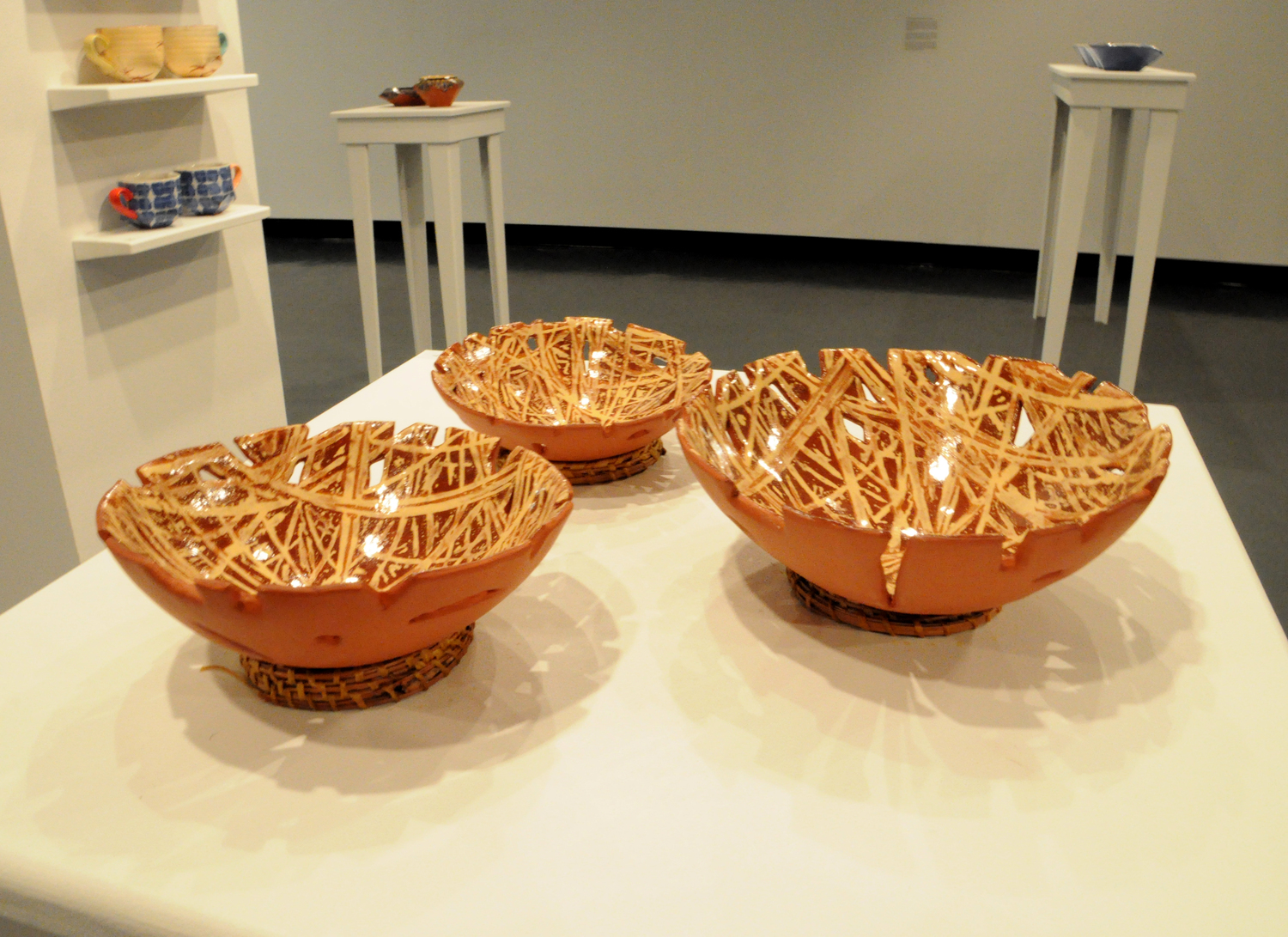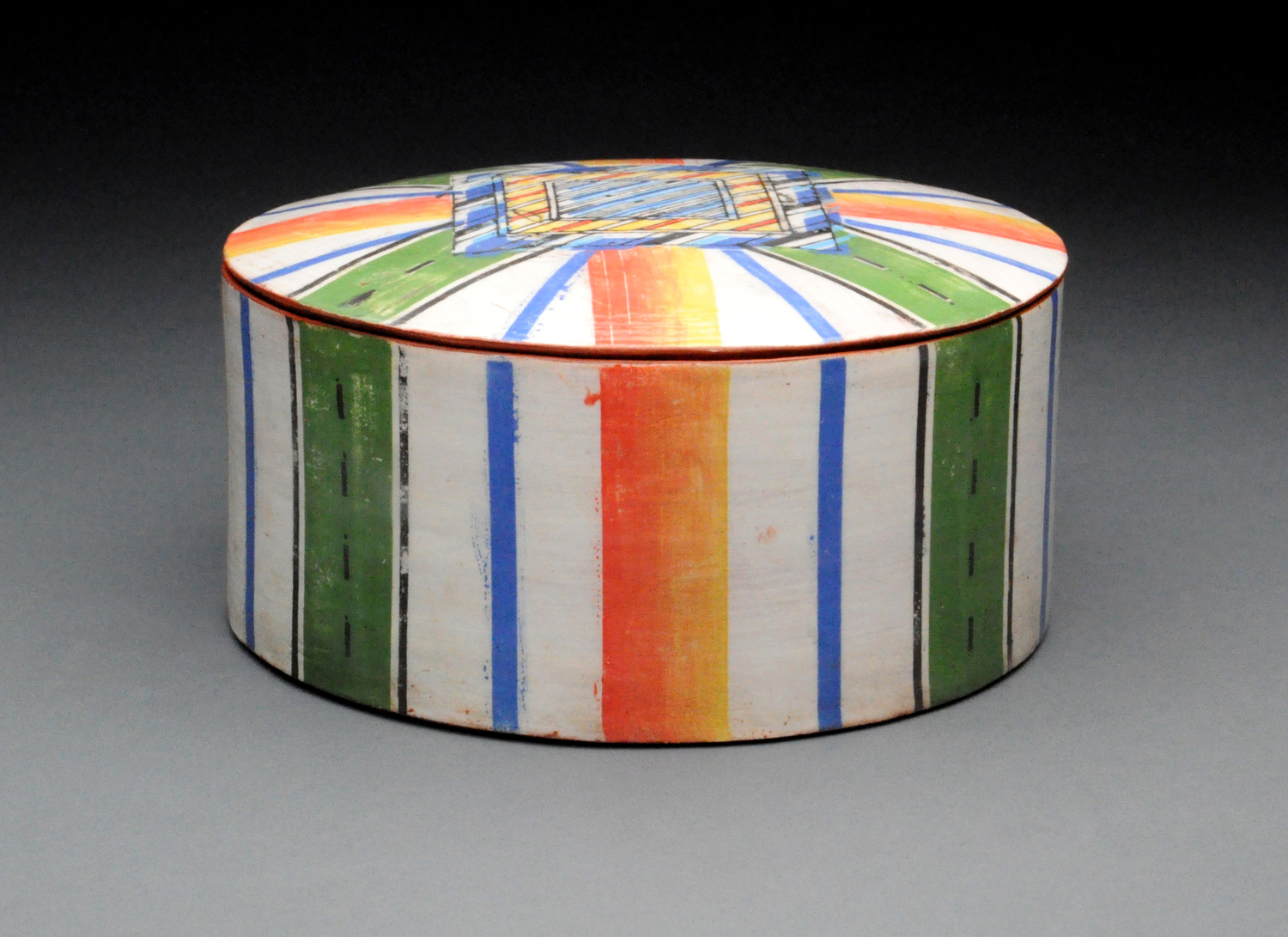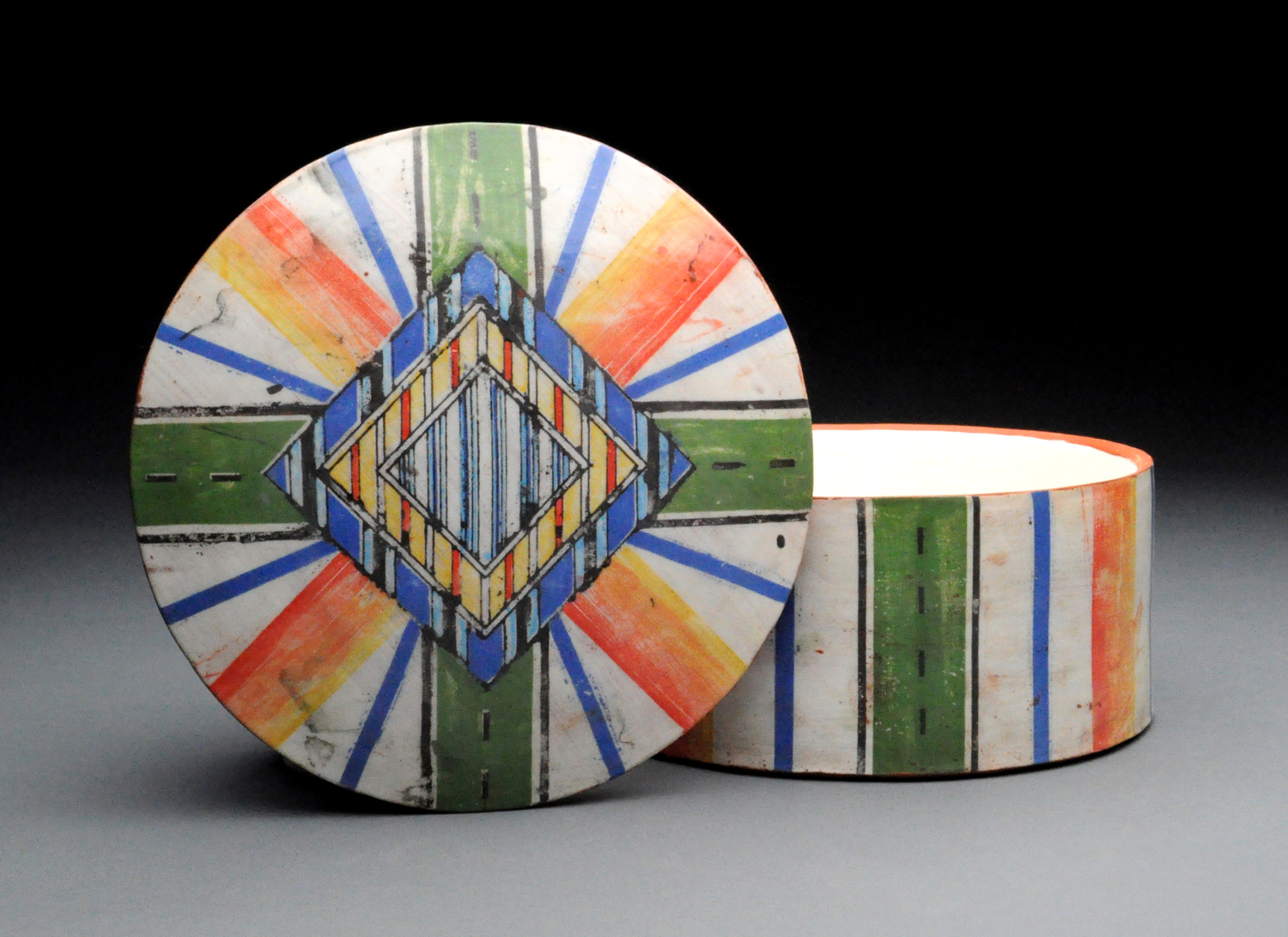Nourishing Connections
MFA Thesis Exhibition 2014
This body of work is inspired by people with whom I have interacted. The work reflects each person - their character, aesthetic, passions, culture, and environment – through my lens. I carefully layer the forms and surfaces with meaning, and through their use they have the ability to influence experiences. Made from earthenware and patterned with slip-transferred designs, each piece is food safe. As my work conveys nourishment to our bodies, I hope that relationships and connections will continue to grow.
Coffee Corner Connections
Meadowlark Hills is a retirement community in Manhattan, KS. I brought 25 pairs of mugs there for residents to drink coffee during their weekly “Coffee Corner” event. Independent-living and assisted-living residents were invited, with a special invitation going out to new residents with the goal of connecting strangers living under the same roof. When residents entered the community room they choose one of my handmade mugs for their coffee. The patterns on the mugs were made in pairs, and the residents found the person whose pattern matched their own. The first conversation starter with their new friend was to share stories about an object that was meaningful to them. After twenty minutes of conversation they found their next partner by matching the color of the handle on their mug. This conversation was prompted by sharing stories about anyone in their family with whom they would choose to have coffee. The goal of this activity was for residents to connect with people they might not otherwise talk to and thereby build the community at Meadowlark.
My Mothers Nurturing
In collaboration with Lynn Karle
My mom is very connected to people and places. She has nurtured and encouraged me through my whole life. She understands me without my needing to explain myself. When I left home to go to college she used her mother’s saying, “You raise them to let them go.” Each year throughout my childhood we took a family vacation to Northern Wisconsin, and in retirement my parents moved there to be surrounded by wildlife and nature. My mother used sinew and pine needles to weave the base that supports the vessel that I created from clay.
Serving with Kelsie
In collaboration with Kelsie Doty
This pitcher and cup set was developed in collaboration with textile artist Kelsie Doty. After searching for fair-trade fabrics from around the world she found a striped textile from Ghana called Kente cloth, which is created by hand sewing together numerous strips of 5” to 6” wide hand-woven cloth. Further research of the culture and climate led us to design a pitcher for cold drinks. We also wanted a vessel that was about serving others, something that would encourage people to share a common experience. Together we designed a serving set that integrates the fabric from Ghana with the clay pitcher and cups. As she was sewing, Kelsie paid special attention to the salvage (self-finished edge) of the Kente cloth, so the process of making kept the fabric’s story intact. By working with a textile artist we were able to unite two different crafts that reflected similar cultural significance.
Learning to Make Flour Tortillas with Aunt Blanca
After my first trip to Saltillo, Mexico I could not forget the flour tortillas. We ate them with almost every meal: with eggs for breakfast, meat with various kinds of sauce for lunch, and as quesadillas with slices of ham and cheese for dinner.
When I had the opportunity to return to Saltillo the family arranged for Aunt Blanca, the best known tortilla maker in the family, to teach me how to make these amazing tortillas. I was honored that she was willing to share such an important family tradition with me. Starting with measuring the ingredients I learned methods different from my own. Weighing the flour and lard rather than measuring it by volume was new to me. I loved the physicality and tactile quality of the smooth lard and flour squishing between my fingers. Working with the dough reminded me of forming clay. Some of my skills could directly translate, so I was put in charge of rolling the tortillas to an even thickness. Other parts did not come so naturally. I watched Aunt Blanca’s practiced hands form the testalas quickly and evenly as I struggled to shape one in the time she made three.
Arroz con Leche with Adriana
Adriana chose to cook arroz con leche, or Rice Pudding, with me because it was something her grandmothers made for her as comfort food. She told me about the unspoken competition over which grandmother could make better arroz con leche, and how they used the dish to spoil their granddaughter. As a pastry chef, Adriana has high expectations for sweets. Although this is simple and traditional it remains her favorite. I could relate to this type of comfort food and we connected by sharing traditions and interests of our cultures and families.
Bhujna and Chapati with Pinakin
Pinakin is a PhD student from India who has lived all over the world. Despite many of the elaborate Indian dishes his mom can prepare, he always requests Bhujna when he has the chance to return home. He appreciates its simple ingredients and efficiency of preparation. I was thankful for a basic recipe and mindless chopping, because as we cooked Pinakin shared his extensive knowledge of philosophies and the world.
Nohema and Alejandra Share Café con Capirotada
While I was doing an internship in Puebla, Mexico I asked Chef Nohema if she would be willing to teach me a meaningful recipe. She invited one of her students, Alejandra, to participate. Alejandra’s mom came up with the idea to make capirotada and offered to bake the special bread needed for it. She sent it 300 miles from her bakery in Michoacan to Puebla. On the way it got lost. Nohema and Alejandra tracked it and picked it up at a storage warehouse because they were determined to have it in time.
Capirotada is something that Nohema and Alejandra miss that reminds them of home. Nohema had not eaten it since she moved to Puebla six years before. It is not something found in restaurants because it is usually made in the home. They both enjoy it because it is sweet and comforting in winter. It is sometimes served as a dessert and often eaten in the evening with coffee or tea. In different parts of Mexico traditions vary. Nohema’s family does not dip the bread in the egg batter, instead soaking it with molasses right away. She traditionally eats it at Christmas, while Alejandra’s family usually eats it during Semana Santa, or Holy Week, during Easter celebrations. No matter when they have it, they said they will always think of cooking together when they have capirotada.
Christmas Morning Blueberry Go-Round by Grandma Karle
Every Christmas my grandmother bakes a blueberry coffee cake. Thinking of the cake reminds me of being in the kitchen on Christmas morning with her, my grandpa, mom, dad, sister, brother-in-law, and my boyfriend when we are all anticipating the events and celebration to come. The cherries on top of the coffee cake are festive and remind me of her rosy cheeks as she cooks in the kitchen. The red circles on the platter mimic the cherries on top of the coffee cake. The design repeated in the circles is inspired by a lace doily my grandma has in her house. I know that my grandmother bakes the cake for me because it is my favorite. My whole family teases me when I eat the most.
Norwegian Lefse in Honor of Brian and His Brother Dan
Dan was put into foster care when he was two years old. His foster mother, Ruth, was from Scandinavia and made kurpsau as a special meal for her family. Dan fell in love with it so she began to make this as a special meal for him as well. Before being adopted Ruth made a scrapbook of things Dan enjoyed during the two and a half years he lived with her. On the last page of the book was the recipe for this Scandinavian dish. Brian has been one of my closest friends since we met as undergraduates eleven years ago, and I’ve had the privilege of eating this with him when we have visited his parents. They continue to gather around this dish as a family for Christmas breakfast and when people visit.
Kay’s Banana Cream Pie
Kay and I made banana cream pie together because it is a special recipe that she makes for her husband’s birthday each year. While cooking I got to know Kay’s strong-willed and passionate personality. I felt that we were kindred spirits, and although we had only met once previously we had meaningful conversations about many things in life. I felt as though she inherently understood me, and as we cooked she offered insightful advice. Since cooking together we have continued to keep in touch for thought-provoking conversation, each offering her generation’s perspective on contemporary issues.
Four Generations of the Jossie Family’s Chicken Soup
Teresa Jossie’s mother often told her of the pot of soup that her own mom, Teresa’s grandmother, kept on the stove. The family had very limited means during the 1930’s. The vegetables were grown in their own garden and chickens were butchered by her grandfather in the morning in the backyard. Teresa told me the story of how her grandmother would add more water to the soup when an unexpected guest showed up for dinner so that there would always be enough food for everyone.
Teresa’s mother made chicken soup by simmering leftover chicken bones, carrot peelings, onions, and celery. The vegetables, along with the chicken bones, were scooped out and discarded, leaving the flavorful broth. For her mom’s soup, unlike her grandma’s, the chicken and vegetables were store bought. She then added freshly cut vegetables, fresh chicken, and a variety of herbs.
Today Teresa’s chicken soup is a long way from her grandma and mom’s versions but has its own richness that her family loves. Teresa conveys her understanding of how food and culture reflect and connect people when she says, “I love how soups are a common connection between generations and cultures. The concept of adding meats and vegetables is the same idea. The preparation techniques speak of the generation or culture itself.”
For Indian Roti in Honor of Ranjit
When I moved to Manhattan for graduate school I did not know much about Manhattan nor anyone who lived here. In order to meet new and interesting people I signed up to be paired with an international student. Ranjit, a PhD student in civil engineering from India, had been studying in Manhattan for four years before we met. Our “local” and “foreign” roles seemed to reverse as he introduced me to people and showed me places around Manhattan such as Pillsbury Crossing. We often cooked together and Ranjit taught me how to make many different Indian dishes. Our similar curious and adventurous personalities far outweighed our cultural differences.





















Gallery View